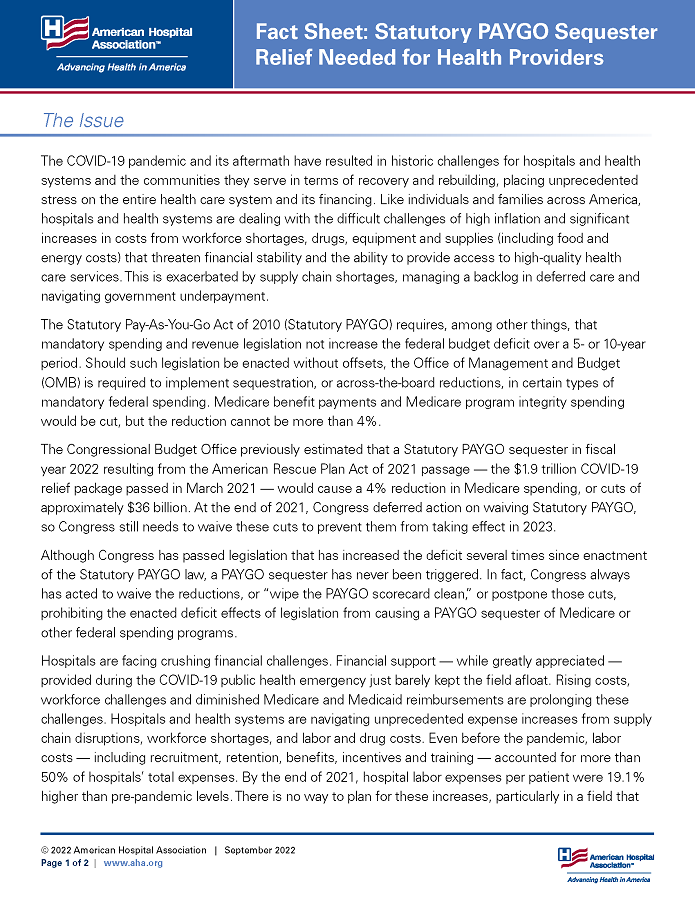

Fact Sheet: Statutory PAYGO Sequester Relief Needed for Health Providers
The Issue
The COVID-19 pandemic and its aftermath have resulted in historic challenges for hospitals and health systems and the communities they serve in terms of recovery and rebuilding, placing unprecedented stress on the entire health care system and its financing. Like individuals and families across America, hospitals and health systems are dealing with the difficult challenges of high inflation and significant increases in costs from workforce shortages, drugs, equipment and supplies (including food and energy costs) that threaten financial stability and the ability to provide access to high-quality health care services. This is exacerbated by supply chain shortages, managing a backlog in deferred care and navigating government underpayment.
The Statutory Pay-As-You-Go Act of 2010 (Statutory PAYGO) requires, among other things, that mandatory spending and revenue legislation not increase the federal budget deficit over a 5- or 10-year period. Should such legislation be enacted without offsets, the Office of Management and Budget (OMB) is required to implement sequestration, or across-the-board reductions, in certain types of mandatory federal spending. Medicare benefit payments and Medicare program integrity spending would be cut, but the reduction cannot be more than 4%.
The Congressional Budget Office previously estimated that a Statutory PAYGO sequester in fiscal year 2022 resulting from the American Rescue Plan Act of 2021 passage — the $1.9 trillion COVID-19 relief package passed in March 2021 — would cause a 4% reduction in Medicare spending, or cuts of approximately $36 billion. At the end of 2021, Congress deferred action on waiving Statutory PAYGO, so Congress still needs to waive these cuts to prevent them from taking effect in 2023.
Although Congress has passed legislation that has increased the deficit several times since enactment of the Statutory PAYGO law, a PAYGO sequester has never been triggered. In fact, Congress always has acted to waive the reductions, or “wipe the PAYGO scorecard clean,” or postpone those cuts, prohibiting the enacted deficit effects of legislation from causing a PAYGO sequester of Medicare or other federal spending programs.
Hospitals are facing crushing financial challenges. Financial support — while greatly appreciated — provided during the COVID-19 public health emergency just barely kept the field afloat. Rising costs, workforce challenges and diminished Medicare and Medicaid reimbursements are prolonging these challenges. Hospitals and health systems are navigating unprecedented expense increases from supply chain disruptions, workforce shortages, and labor and drug costs. Even before the pandemic, labor costs — including recruitment, retention, benefits, incentives and training — accounted for more than 50% of hospitals’ total expenses. By the end of 2021, hospital labor expenses per patient were 19.1% higher than pre-pandemic levels. There is no way to plan for these increases, particularly in a field that routinely struggles to break even. This financial instability threatens access to care for patients and communities. Without a critical lifeline from Congress, hard choices will need to be made regarding services, staffing and patients’ access.
AHA Take
Now is not the time for reductions in Medicare payments to providers. Congress has always acted to prevent or postpone a Statutory PAYGO sequester in years when legislation has been enacted that increases the deficit. Congress must do so again this year — enacting into law provisions to prevent a Statutory PAYGO sequester from taking effect at the end of this session of Congress. Congress must prevent 4% cuts to Medicare from taking effect so hospitals and health systems can continue to care for patients, families and communities.


